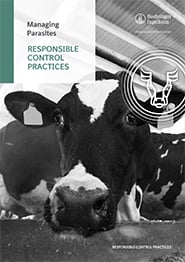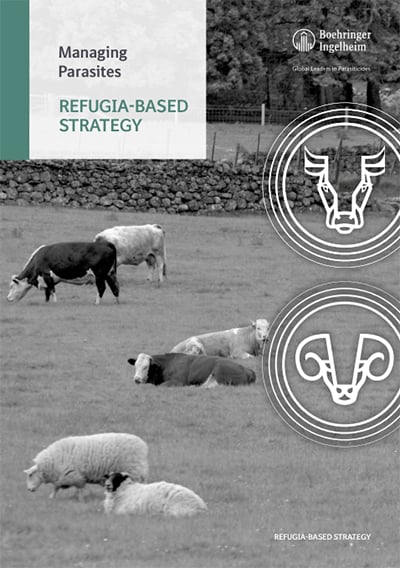With increasing concerns about cattle wellbeing, the environment, biodiversity and the development of resistant parasites, promoting the responsible use of anti-parasitics is essential.
There are three underlying principles:
This process involves all players: pharmaceutical companies, diagnostic labs, veterinarians, animal health advisors and farmers.

Proper diagnosis is crucial to make a sound decision about parasite control strategies.
Current diagnostics identify parasite presence and indicate relative level of infection. This is a critical indicator of potential impact on an animal or herd and is vital information in making the decision as to which treatment protocol to implement. Some diagnostic tools provide the identification of the worm, which allows selecting the product with the right spectrum of action.
Parasites can be internal (endo) or external (ecto), and can use animals as hosts or live in their surroundings, in the manure and on the pasture (free living stages). They vary depending on the climate, season and husbandry/management.
Parasites can have a negative impact on growth, weight gain, productivity, reproductive health and can even lead to the death of the animal in severe cases.
Utilising diagnostic tools will identify which parasites are of concern and help decide on appropriate treatments.
The most common diagnostic test for GI nematodes. A faecal sample is collected and after dilution and microscopic identification and counting, results are reported in eggs per gram faeces. This helps identify the parasite burden.
As parasites reduce liveweight gain, regularly weighing cattle and intervening when growth is lower than expected ensures that parasites do not cause excessive production loss.
Blood serum pepsinogen concentration thresholds vary between laboratories1.
ODR is an ELISA-based test to detect Ostertagia ostertagi in milk samples from dairy cows. Also called the MOO test (Milk Ostertagia Ostertagi), it can be used on an individual or herd level. It detects antibodies against Ostertagia in milk samples2.
When animals are put on pasture, some are more susceptible to parasitism than others. The parasite control programme will vary depending on their age and level of immunity.
are very susceptible to parasites in their first grazing season. The parasite burden in the animal can impact animal performance and even result in diseases (diarrhoea, death). A treatment during the grazing season is usually necessary.
diagnostics should be considered. Treatment may or may not be indicated. If no treatment is given at the start of the grazing season, cattle should be monitored closely and further diagnostics done later in the season.
adult cattle develop acquired immunity against some parasites. Nevertheless, the impact of parasite burden should be monitored though diagnostics and treatment administered accordingly.
The development of immunity is progressive. When established, it helps in:3
A sufficient time of effective contact4 (TEC) with the infective larvae of parasites is necessary to build up immunity, before the first calving. In cattle, eight months is considered an adequate TEC.
Pasture management is an essential component of parasite control. It is often estimated that 95% of parasites are on pasture and only 5% in the animal5.
Pasture parasitic load depends on the season, temperature, humidity, animal density, forage type and rainfall, as well as the parasite control practices implemented by the farmer and on neighbouring farms.
All these variables need to be taken into account to reduce the parasitic load and minimise the impact on productivity in your farm.
A sustainable approach involves the correct use of anti-parasitics: the right dose, the right product, the right time and on the right animals. Historically it was common to worm the entire herd. Blanket deworming of all animals results in increased anti-parasitic resistance.
Strategic treatment – plan the treatment of groups of animals based on previous experience/history to minimise worm burden, pasture contamination and disease (can be part of refugia strategy).
Targeted treatment (TT) – treatment of groups of animals based on assessment of current parasite risk (e.g. treating at first grazing season when FEC indicates it) (can be part of refugia strategy).
Targeted selective treatment (TST) – treatment of individuals or subgroups based on an assessment of current parasite risk (e.g. treating only poorer doing calves). Often discussed is leaving a small proportion of animals untreated (can be part of refugia strategy).
Therapeutic treatment – treatment in response to clinical disease.
References

The following information may only be viewed by veterinarians, SQPs/RPs or farmers.
Please confirm that you are eligible to view this information:
Yes I am a veterinarian, SQP/RP or farmer
Technical Services
For technical enquiries or to report an adverse event, please use the following contact details:
Ireland: +353 (0)1 291 3985
VetEnquiries@boehringer-ingelheim.com
Customer Support Centre
For marketing and general enquiries:
Ireland: +353 (0)1 291 3985
Further information available from Boehringer Ingelheim Animal Health UK Ltd, RG12 8YS, UK.
The steerhead logo is a registered trademark of the Boehringer Ingelheim Group.
© 2024 Boehringer Ingelheim Animal Health UK Ltd. All rights reserved. Date of preparation: Apr 2019. AHD11105.
Use Medicines Responsibly.